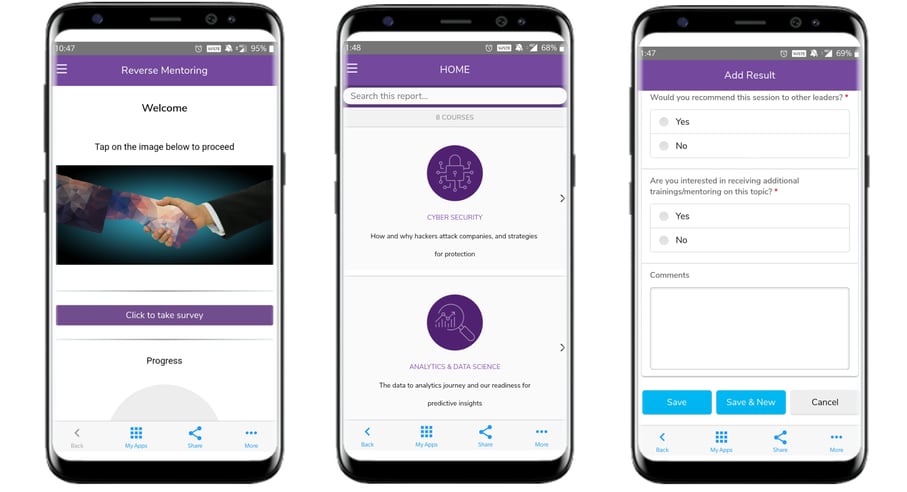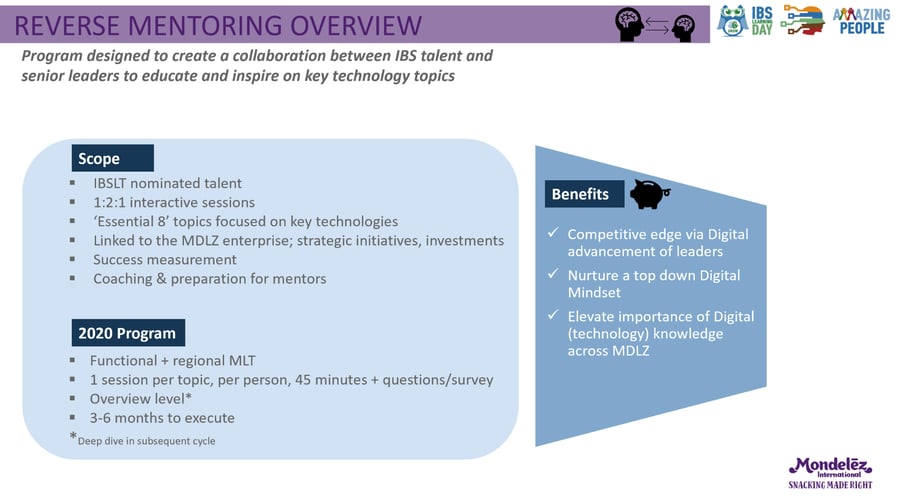Program Vision and Strategic Leadership
Program Concept and Purpose: The Reverse Mentoring program is designed to foster collaboration between talented IBS (Information and Business Solutions) professionals and senior leaders. The goal is to educate and inspire leaders on key technology topics using No-code/Low-code development platforms. The program empowers senior leaders to gain hands-on exposure to cutting-edge tools and methodologies while leveraging the expertise of IBS talent in a mutually enriching relationship.
Strategic Role and Leadership:
Program Design: I led the program design by defining key objectives: bridging knowledge gaps, fostering innovation, and strengthening cross-functional collaboration.
Stakeholder Engagement: Strategically aligned the program with organizational goals by engaging senior leaders, technology experts, and HR teams to ensure buy-in and support.
Phased Implementation: Guided the initiative through multiple phases, from ideation and pilot testing to full-scale deployment.
Defining Success Metrics:
Increased adoption of No-code/Low-code tools by senior leaders.
Enhanced collaboration between IBS talent and leadership teams.
Improved digital literacy and innovation culture within the organization.
Demo Video


Few screens from the app
Conclusion
By strategically leading the Reverse Mentoring program and applying a user-centric design approach, I ensured the development of an application that not only meets organizational goals but also delivers measurable value to its users. The iterative UX/UI process ensured the application is intuitive, engaging, and aligned with the vision of bridging the knowledge gap between leaders and technology experts. This initiative became a cornerstone for fostering digital literacy and collaboration within the company.
Take away from working with LC/NC
Pros
Fast Development: Speeds up prototyping and deployment with pre-built components.
Ease of Use: Non-technical users can build UIs using drag-and-drop tools.
Cost-Effective: Reduces dependency on large development teams.
Iterative-Friendly: Simplifies updates and allows quick changes.
Responsive Design: Built-in tools ensure compatibility across devices.
Integration Ready: Easy API and third-party tool connections.
Encourages Innovation: Low barrier for teams to experiment and create.
Cons
Limited Customization: Pre-defined components may restrict design flexibility.
Scalability Challenges: May struggle with complex or large-scale projects.
Vendor Lock-In: Difficult to migrate applications outside the platform.
Generic UX: UIs may lack uniqueness or advanced features.
Code Access Issues: Limited control over underlying code hinders debugging and optimization.
Compliance Concerns: Platforms may not meet strict security or privacy standards.
Learning Curve for Advanced Use: Complex scenarios may still require technical expertise.
Bottom Line: Ideal for rapid, simple, and cost-effective UI creation but not for projects requiring heavy customization, scalability, or full control.


Process Overview
The six-step process used for successful project execution.


Research & Discovery
Understanding user needs and market opportunities for success.


UX Design
Creating intuitive user experiences that engage and delight.




UI Design
Crafting visually appealing interfaces that enhance usability.
Development Handoff
Seamless transition from design to development for efficiency.


Testing & Iteration
Feedback rounds with user groups to assess their interaction with the prototype and fix bugs, if any.


Launch & Post-Launch Enhancements
Final launch then moving to planning roll out for new features and more.
Strategic Threads By Saachi Sharma
Crafting unique experiences through thoughtful design solutions.
Connect
© 2024. All rights reserved.